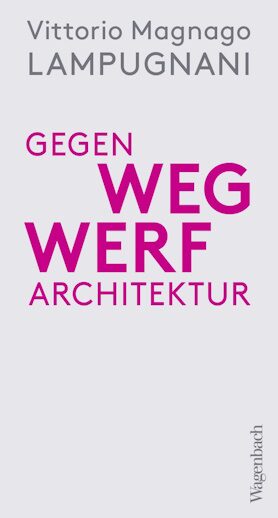Vittorio Magnago Lampugnani
Gegen Wegwerfarchitektur. Dichter, dauerhafter, weniger bauen
[Down with throwaway architecture. It’s time to build more densely, more durably - and less]
¬Down with showy architecture! Vittorio Lampugnani advocates for urban development that (almost) dispenses with new construction
Lampugnani has acquired a solid reputation as an urban-planning conservative over the years. And nothing gets his hackles up more than the construction of self-indulgent and hackneyed one-off designs by so-called star architects. When it comes to the classical architectural avant-garde, Lampugnani has mixed opinions. Le Corbusier and Gropius were surely not proponents of the traditional urban ideal, but their designs came close to Lampugnani’s notions of “dense” and “durable” (though admittedly not “less”). If Frankfurter and Karl-Marx-Allee in Berlin are valued nowadays for their socialist workers’ palaces, then this has to do with a shift in public perspective. We appreciate these boulevards today neither for ideological reasons nor because we have a soft spot for pomp; we like them because they are uniformly and solidly built. These are qualities that Lampugnani praises, holding them up against the sins of postmodernism and other such aberrations born from the spirit of “singularity.”
But if, at bottom, we can only agree with Lampugnani’s critique and diagnosis, why do these good intentions so often go unheeded in architectural practice? It is an unholy alliance between architects themselves as well as developers and the construction industry that Lampugnani blames for the “inhospitality of our cities” (to quote Alexander Mitscherlich’s well-known book from the 1960s). There are architects and architects, according to the author. Some, like Lampugnani himself, are interested in repairing, densifying and in any event preserving existing buildings. Others would like to be rich and famous, which low-key restoration projects are unlikely to make happen. This, in turn, is usually the fault of contractors, who are keen to erect a monument to themselves – a fundamental problem in the business of architecture. And behind them lurks the construction industry, which is only marginally interested in building “more densely, more durably and less.” Lampugnani’s nightmare is the sprawling, peri-urban area desolated by commuters, an area that is neither town nor countryside. His desire to protect nature does not mean he wants to see it move into the city – apart from parks and gardens, which are anything but nature. He has only a measured interest in urban gardening, and is reluctant to join in the hoopla surrounding the “passive house” – superinsulation and electricity generation by means of photovoltaic systems, a trend the construction industry has avidly promoted. Not every progressive architect and politician would be pleased with his conclusions, but Lampugnani, again, is clearly conservative in such matters. And a radical conservative at that. We shouldn’t be building at all, he argues. Today’s alleged housing shortage is the result of a steadily increasing use of land per person. Our old towns and inner cities could easily accommodate a growing population, he thinks, even one that prefers to live in one-person households. People would just have to change their lifestyle. A detached house in the suburbs is no longer a suitable form of housing, argues Lampugnani, especially if these homes are being built from scratch. He makes the case instead for “dense, socially and functionally mixed neighborhoods with an appropriate use of land in between, pedestrian-friendly public spaces with a high quality of living,” and other positive things. Anyone with a heart for the traditional city – the beautiful, functional and organic kind one can still encounter and inhabit in Europe and other places around the world – will be thankful to Lampugnani for his vehement opposition to “disposable architecture” and his commitment to an urban development in the spirit of preservation.
Translated by David Burnett

By Christoph Bartmann
Christoph Bartmann was director of the Goethe-Institute in Copenhagen, New York and Warsaw. Today he lives and works in Hamburg as a freelance author and critic.
Publisher's Summary
This is a radical plea for an architecture that renounces the throwaway ideology of capitalism; and an attack on ill-thought-through claims that isolated instances of damage-limitation are actually attempts at achieving ‘sustainability’.
‘Build more densely, more durably and, above all, less’, says architect and historian Vittorio Magnago Lampugnani.
The concept of sustainable building is on everyone’s lips. Most suggestions in this regard opt for footling measures such as installing insulation panels (which Lampugnani calls a ‘fundamentalist attempt to hide the problem’), or outlawing concrete. But much more differentiated and more comprehensive thinking is needed in order to create top-quality housing that makes for long-term sustainable accommodation.
Lampugnani sketches out a brief history of urban and architectural consumerism and uses this as a springboard for his reflections on creating a culture of truly sound sustainability. He denounces the ruination of nature through urban sprawl and pleads for a strategy based on density: only compact cities can be ecological.
In order to reduce the immense consumption of raw materials and energy occasioned by house-building he calls for a complete turnabout: a renunciation of the practice of opening up ever more areas for building purposes, and of wantonly using up raw materials. Instead of demolishing buildings and replacing them with new ones, we should be converting, repurposing and extending them. The longer a building lasts, the more ecological it is.
(Text: )
